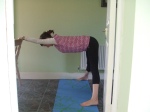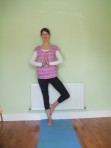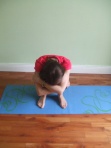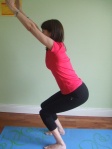I have never met anyone who doesn’t enjoy this pose in some form. It is just fabulous for releasing tightness in the back and hamstrings. However, you have to be careful that the back doesn’t become dome-shaped. So use a chair in the beginning to learn (a) how to align the spine correctly and (b) how to rotate the pelvis forward around the tops of the thighs.In the full version of the pose, the head rests on the floor creating a gentle inversion for the body. This brings a fresh supply of blood to the head and heart, thus revitalising the entire system. As a forward bend, the pose cools and calms the mind. But don’t be tempted to go for gold just yet. Work with the chair first and get the alignment right, and in time this position will be one of the most rewarding in your repertoire!
How to practice Wide Leg Forward Bend (Part 1):
- Stand arms-length away from the back of a chair. Make a very wide distance between the feet. Check that the feet are parallel.
- Place your hands on your hips. Inhale, exhale, bend forward from the hips and hold the back of the chair. Take your head down in between the arms.
- Each time you inhale, lengthen the entire front of the body. Also lift up the arches of the feet and the inner ankles. Each time you exhale, take the feet slightly further apart (but only if it is comfortable to do so) and lengthen the entire spine pushing back through the hips. The aim is to rotate the pelvis forward around the tops of the thighs until the sitting bones are in line with the ceiling. You can check this by reaching back and feeling for the bones. It could take a while before you get this movement. Most of us have very tight legs from so much sitting and this hinders the rotation of the pelvis. Take your time. When the sitting bones finally cooperate, you can do without the chair and move on to Part 2.
- Stay for 6 breaths. To come up, each time you inhale, gradually shuffle the feet closer and closer together until you are back in Mountain Pose.
(Part 2)
- As you exhale, take the feet slightly further apart (if possible) and rotating the pelvis further forward, place the hands on the floor underneath your shoulders (or on a yoga block or box if you can’t reach). Do not rest the weight of the body on your hands but keep it on the pelvis and upper thighs.
- Keep lifting the sitting bones and the tailbone up towards the ceiling. Relax the shoulders downwards. Look through the legs.
- If you can, gently place your head on the floor.
- Stay for 6 breaths. To come back up, each time you inhale, gradually shuffle the feet closer and closer together until you are back in Mountain Pose.
NEED HELP?
~ If your back is dome-shaped, bend the knees slightly and work on rotating the sitting bones upwards from this stance instead.
~ If your legs are not strong or if they are very tight, sit astride a chair instead. Make sure both feet are parallel and then proceed as outlined above.
STOP!
~ Proceed carefully if you have any disc problems or are suffering from groin strain.
~ Do not bring the head lower than the level of the heart if you have glaucoma or detached retina.










